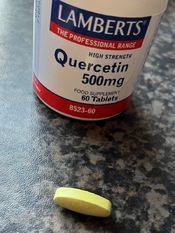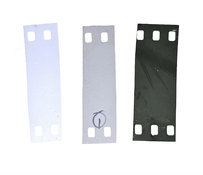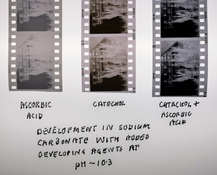My quercetin tablets arrived today! It being Saturday, after I was done with the domestic agenda in the morning, I had time to try an experiment.
I had two things I wanted to test:
- On a hunch, I thought I'd like to see if triethanolamine would improve solubility of quercetin
- Can we show any superadditivity between ascorbic acid and quercetin itself?
This is the setup:
- Got 1 500mg quercetin tablet from the jar. This contains a few things that are not quercetin. I will post below.
- Crushed it as much as humanly possible with a dedicated pill crusher (these are cheap!)
- Mixed it with 2ml of triethanolamine into a British mustard-like consistency and color
- Added to 100ml of tap water
- Did not filter, just stirred once a minute to keep in suspension
Since I have gotten my new pH meter but not yet calibrated it, I tested pH with paper. Starting pH of the above was high 9s, ~9.7-9.8 guessing from previous experience.
I then ran a few tests for 10 minutes each, at 68F, using snippets of that old Fomapan 400, my perennial test dummy:
- Quercetin alone
- Quercetin with 1.6g of ascorbic acid, pH about 8.8
- Quercetin with 1.6g ascorbic acid, pH matched back to the high 9s with paper (more info below)
Some interesting observations:
- The quercetin (or other pill components) does not all dissolve, not even close
- At higher pH it seems to stay in suspension better than at lower pH
A few caveats:
- I had a heck of a time getting the pH back up to high 9s once the ascorbic acid was added. I added a lot of sodium carbonate and then gave up and added some more TEA since my carbonate is old and may have become bicarbonate. This means that if TEA does improve solubility of quercetin in water, then this experiment does not entirely show the possible superadditive properties of the two agents, because the latter test contains more TEA.
- There might be something in the pill that is affecting development
- I did not test ascorbic acid by itself in the same configuration
That being said, the pill ingredients are:
- Quercetin dihydrate
- Calcium carbonate
- Cellullose
- Anti-caking agents:
- Stearic acid
- Silicon dioxide
- Magnesium stearate
- Pill coating:
- Hydroxypropyl methylcellulose
- Glycerin
The results:
The quercetin alone does develop film, but not very well. Quercetin and ascorbic acid together appear to be a strong developer. Since I think the only main difference from
@Alan Johnson 's earlier testing is that there is more ascorbic acid, I can only presume this is why it works faster. I am not certain if the streaking on the darkest test strip is from sediment settling on it and increasing the concentration, or something that may have happened to this clip of film sitting in my box.
All tests are fixed with Ilford Rapid Fixer, which is acidic and may eliminate stain.
Densities:
- Fixed Fomapan 400, no development: 0.34
- Quercetin alone: 0.61
- Quercetin with 1.6g of ascorbic acid, pH about 8.8: 0.65
- Quercetin with 1.6g ascorbic acid, pH matched back to the high 9s: 1.25 (!)
I'm attaching some photos of the setup and the results on the light table. Since these are not real photos, it's hard to say anything about fog conditions.
Last photo is Fomapan fixed without any dev, quercetin alone, querceting with 1.6g ascorbic acid and pH matched

















